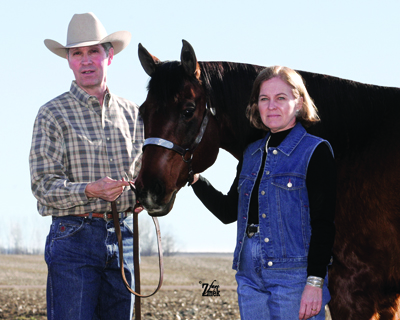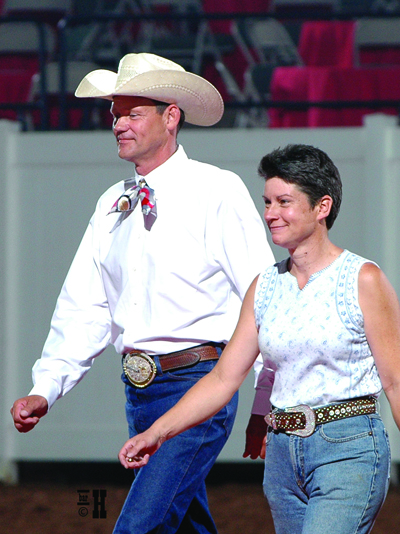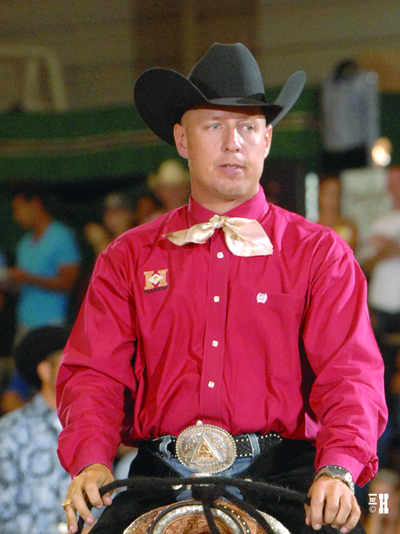
 Dan & Carol McWhirter
Dan & Carol McWhirter
American Quarter Horse Association Leading Breeders, Dan and Carol McWhirter, have developed a breeding program that paved the path of the modern Western Pleasure horse. The Big Investment and AQHA Hall of Fame stallion, The Invester, were just the first in a long line of sires from this Doniphan, Nebraska farm. Miss Rebel Rita may be their most notable broodmare, dam of Investment Asset and Good Asset, both AQHA leading sires, and whose foals have earned over $1 million. At the peak of their breeding business, McWhirters owned 50 mares, and they all fit Carol’s strict criteria for her broodmares to cross with their stallions. The couple held a dispersal sale in 2011 to cut back their horse business.
Carol takes a very serious, nearly academic, approach to their breeding philosophy. “First and foremost,” she says, “you must have goals – what type of horse are you trying to raise (western pleasure futurity, all around, hunter under saddle), because all three categories have different physical types.” She recalls something fellow breeder, Darol Rodrock, once said. “We have to hang a picture on the wall of our ideal horse, as a goal of where you want to go. Without that goal, you are never going to get there.”
“Breeding is not casual,” she continues. “I’m very passionate about that. We have to breed with a conscience, we have a responsibility to take care to raise the best possible animals we can, and it’s not a frivolous activity. As a breeder, we are responsible to produce individuals for not only your financial bottom line, but we are affecting the breed by the horses we raise. If you can’t do it right, don’t do it.”
“It’s expensive to raise horses, from the gestation period to raising them to show age. You need to do your homework prior to starting a breeding venture. Not every mare is a broodmare and you can’t expect a stallion to fix her faults,” Carol recommends. “I’ve been very fortunate to work with some really smart people and Dan and I have learned from their experience in building our breeding program.”
McWhirter examines both phenotype (physical characteristics) and genotype (genetic characteristics) of the mares. “There is no perfect horse. You have to evaluate with a critical eye and look at the mare without emotion. If a mare has more than one fault, I would not breed her,” Carol says as a matter of fact. If she has the phenotype for a fault, she has the genotype for it, and a 50 percent chance of producing the same. “Give her a good home, give her a good life, but don’t breed her.”
Carol’s first criteria in mare selection is balance. Balance, good conformation and movement all go together. Carol uses her art history education in studying conformation and breeding. “Leonardo da Vinci studied their skeletal structure to draw horses. Dr. Marvin Beeman wrote an excellent article on form to function, giving insight to conformation and how it affects soundness in horses.”
McWhirter horses have always been known for their strong toplines. “We want to produce foals that will grow balanced, and not have that teeter-totter growth pattern,” she explains. “Those $30,000 yearlings have good, level toplines.”
As far as emphasis on the pedigree, McWhirter concludes that the genetic history, the mare’s genotype, will be told in her pedigree.
“Black type on the bottom side makes for great marketability,” she advises. “If your goal is to sell horses, you have to fill a catalog page.” Research, she recommends. “If you can’t afford a first generation, you can find a second generation.”
Her biggest point of advice is to know your families. In addition to conformation qualities, stride styles are important for today’s show horses. Certain families are known to produce mare lines or sire lines.
Go with the strength. Look for a mare whose sire is known for daughters who produce. Once in a while, you will find a stallion who is prepotent – a genetic phenomenon where the stallion will dominate the mare every time. But most stallions need good mares to produce outstanding foals.
Research your families. Tamara Wess, dam of Zippos Mr Good Bar, was by Blondy’s Dude – who was known as a broodmare sire.
Families have particular conformation characteristics and stride styles. It’s not just low hocks, it’s the set and angle of the hock and stifle. You have the long strided horses, with deep reach that move close to the ground and you have the tighter strided horses that move with more lift. McWhirters would blend styles of stride (tighter vs. longer) to try to end up in the middle. Carol says Good Asset was slow legged and moved close to the ground. The Big Investment had a tighter, lifted through his back.
IF WE GAVE YOU $50,000 TO SPEND, HOW WOULD YOU GO ABOUT IT?
“I’d be cautious. I might buy an embryo. Or I’d look for a Blue Hen Mare,” McWhirter says. “A Blue Hen Mare is the one we all dream of – the mare that will produce an outstanding individual on her own traits. Carol offers Miss Rebel Rita and Vital Signs Are Good as examples of Blue Hen Mares.
Darrell Saul owned Zippos Mr Good Bar at the start of his breeding career,
during which time he stood at McWhirter’s alongside The Invester. In addition to the advice from Darol Rodrock that guides Carol, Saul also gave her words of wisdom: “Buy the mother of a proven show horse; she’s proven she’s a producer.”
 Tim & Barb Delf
Tim & Barb Delf
Insisting it’s quality and not quantity, Barb and Tim Delf own just a handful of mares at their Blue Grass, Iowa home. With mares like Dublin Darlin, Goodbars Glamourgirl, Annie Dell Pine and Quit Staring TB, they’ve proven it’s more than luck. The couple raises a few foals each year out of quality mares, by leading sires, and sells them as yearlings at the country’s top prospect sales.
“When I was in high school, I worked for Jim Bader, the leading AQHA and thoroughbred race horse breeder in Iowa,” Tim recalls. “He ran about 30 mares. Every year, the same three mares had the best and the highest priced foals. These same foals reliably went on to earn the most money. These mares were all good sized, well conformed and had a certain, unexplainable charisma when you looked at them. In my mind, I have always known that to be successful, you need some of these proven producers and I really wanted to avoid having a bunch of average producing mares . When Barb and I first started 30 years ago, we couldn’t afford those good proven mares. We bought the best mares we could afford.”
“I breed every horse like I plan on keeping it and showing it myself, ” Tim explains. I am 6 feet 2 inches, so size is a consideration for me. We bought Dublin Darlin (Sun That Shines x Begorrah). I am sure no one recognizes that breeding. She was a Hempen thoroughbred race horse who could not run a lick. She had a speed index of 36. What she did have was really good conformation – big frame, short cannon bones, low and well set hocks, withers higher than her hip. She was 6.2 hands tall, quiet and pretty. She was a slow, deep loper and pointed her toe at the trot. She produced multiple Superior event, multiple Congress Top 3 and World Show Top 5 horses, and one of our favorite show horses, Double My Assets, who was an AQHA Amateur Champion with Barb and fourth in the Nation in Amateur Performance Halter Mares. She’s now raising foals for us.”
“Another of our first good mares is Goodbars Glamourgirl. She was an unshown mare by Zippos Mr Good Bar out of Mitos Magic Moment. A friend of ours raised her as a pleasure prospect and we bought her when he switched from Pleasure to Reining horses. She was 16.1 hands tall, big framed with withers higher than her hip and really pretty. Her dam had already produced Goodbars Going Grey, a Superior Western Pleasure horse. Buying her was a no brainer for us. Her first foal was Cool Assets (Congress and World Champion). She has now produced six show horses that are earners of over 2,700 AQHA points. Her get are some of the best lopers and lead changers in the country. One, Nothin Compares, is currently leading the nation in Junior Western Riding.”
“Our experience with the good producers is that if you cross them on the right leading sire, they will have a good foal almost every time. The reason we breed to the leading sires is because numbers do not lie. These studs have consistently produced show winners. We take yearlings to the top sales each year. Most of the top buyers will not even look at your horse unless it is sired by a leading sire and out of a mare who has produced multiple winners. It costs so much to make a show horse that buyers want the best prospect possible and are willing to pay a fair price for that prospect.”
When researching pedigrees, Delf puts a strong value on the mare line.
“When we bought Monicas Version (by Good Version) at the McWhirter Dispersal Sale, I bought her because of her conformation and her dam, who had produced five really good show horses, including Struttin Machine. I really believe in the mare lines and in producing mares.”
On selecting stallions for their mares, Delf says “We really like Invitation Only because of his size, confirmation, movement and the fact that he crosses so well with the Zippos Mr Good Bar mares. Investment Asset sired some of our best horses, so he is one of our all-time favorites. We started breeding to Lazy Loper and he appears to cross well with our Zippos Mr Good Bar and Investment Asset mares. For Hunter Under Saddle horses, we have had good luck with Last Detail and These Irons Are Hot.”
IF WE GAVE YOU $50,000 TO SPEND, HOW WOULD YOU GO ABOUT IT?
“Good producing mares are almost priceless,” Delf sighs. “People who have them usually will not sell them for any price. If someone had $50,000 to spend, I would recommend they buy a mare with good conformation, movement and disposition who is out of a proven producing mare and preferably sired by a leading sire. If she has a successful show record herself, or has produced a show winner, that would be even better.”
He grins. “If you gave me $50,000, instead of taking one of our Invitation Only or Lazy Loper fillies out of Goodbars Glamourgirl to a sale, I would keep her for myself.”
 Tim & Katy Jo Zuidema
Tim & Katy Jo Zuidema
Tim Zuidema, of Micanopy, Florida, has an eye for select ing outstanding mares for his broodmare band.
His longtime business partner, “Uncle” Art Juhrend, handles the breeding and foaling business. The foals then go to Tim as long yearlings, when they are ready to start training and showing. Their program has produced great horses in the ApHC industry, such as Chocolatey, Color By Chocolate, and Hot Chocolate Chip. The team has consistently produced winners at the ApHC National and World Championship Shows.
“We are raising foals that will go into my training program, so basically I’m looking for ones that will suit me and my style of training,” says Zuidema. When looking for a mare to add to their broodmare band, Tim looks first at their pedigree, then the invididual, and then her own show record. That pedigree gives him the family history of proven producers. Handfull Of Chips is an example of the mares they have raised by Hot Chocolate Chip that found their place in the broodmare band for Juhrend and Zuidema.
“A good pedigree will increase the marketability of the foals,” he says, “and some of the best mares have not had a great show record themselves (for various reasons and circumstances, such as injury). So he uses all three qualifiers to help him decide if a mare will fit into their breeding program. “We mainly breed to our own stallions, so we are making our mare selections based on what will fit our horses.”
Zuidema says when he looks at the pedigrees, he takes a good look at her mother. “I’d take a mare by an OK stud out of a really good mare over one by a really good stud and just an OK mare.”
On the mare as an individual, Zuidema first wants to see balance. “I want to be able to divide her into three parts that are equal,” he explained. His priorities include a low hock set, a short back and he looks for a pretty face. A kind eye and expression gives him an idea of her disposition. He wants the mare to have size and strength to produce colts that will be big, strong and capable two year olds for the futurity programs.
IF WE GAVE YOU $50,000 TO SPEND, HOW WOULD YOU GO ABOUT IT?
Zuidema says he would try to find two mares for his money. “I’d look for a younger mare that may have her own show record, or one that has produced a couple of horses that have performed. I’d look for a nice pedigree that I know will cross well with our stallions.”



You must be logged in to post a comment Login